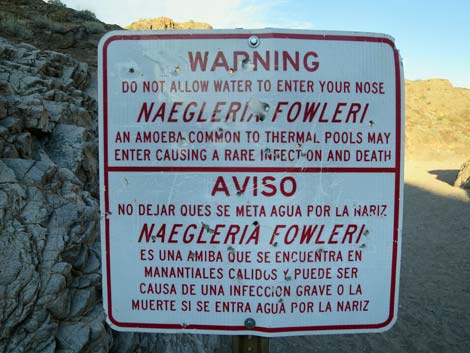
and other Pathogenic Free-Living Amoebae

Signs at some hot springs around southern Nevada and notices on the Internet warn about the dangers of getting a deadly Naegleria fowleri infection while swimming in a hot spring. What is "Naegleria fowleri" and what is the risk?
According to the Center for Disease Control (CDC) website, Naegleria fowleri is an amoeba that is ubiquitous in the environment (it occurs everywhere in the soil, water, and air). Infections in humans are rare and generally acquired from getting contaminated water up your nose. The World Health Organization suggests that swimming pools and spas are the main sources of infection. In untreated cases, death occurs within one week of the onset of symptoms, but drugs can control the disease. This disease is known only from isolated cases. For more information, see the World Health Organization and CDC web sites.
As far as I can tell, one death from Naegleria fowleri has been recorded in Nevada.
It seems to me that the risk of contacting Naegleria fowleri, Acanthamoeba, or other pathogenic amoeba is far less than the risk of dying in a car accident while driving to the hot springs, far less than falling off a cliff along the trail, and far less than developing heat stroke while out during summer. However, just as we wear seat belts to protect against injuries in vehicle accidents, traverse high cliffs carefully, and drink plenty of water, we should take precautions against amoebic infections. Keeping your head above water would seem to do it. So, what I do is enjoy the hot water, keep my face dry, and I just don't worry about it.
That's my opinion and I'm sticking to it. I feel that if we are to worry about such issues, we need first to address the real dangers of outdoor activities: driving, falling, and heat injuries being among the biggest. People have written me complaining that I don't take this issue seriously enough; one even said that 123 people have died of Naegleria fowleri in the last century! OMG -- 123 in 100 years! My reply: how many hikers have died in car wrecks in the last 100 years? How many hikers have fallen off cliffs in the last 100 years? How many hikers have died of exposure in the last 100 years? Sure, I'll keep my face dry, but I'm going to live life to the fullest and enjoy the hot water whenever I can.
Edited excerpts from the CDC Bad Bug Book
Acanthamoeba sp., Naegleria fowleri, and other amoebae
These organisms are ubiquitous in the soil, water, and air. Infections in humans are rare and are acquired through water entering the nasal passages (usually during swimming) and by inhalation.
Name of Organism: Acanthamoeba species, Naegleria fowleri, and other amoebae. Members of these two genera (Acanthamoeba and Naegleria) are the principal protozoa commonly referred to as pathogenic free-living amoebae.
The Disease: Primary amoebic meningoencephalitis (PAM; Naegleria fowleri) and granulomatious amoebic encephalitis (GAE; acanthamoebic keratitis and acanthamoebic uveitis).
PAM (Naegleria fowleri) occurs in healthy people. Central nervous system involvement arises when organisms penetrate the nasal passages and enter the brain through the cribriform plate. The organisms multiply in central nervous system tissues and may be isolated from spinal fluid. In untreated cases, death occurs within 1 week of the onset of symptoms. Amphotercin B is effective in the treatment of PAM. At least four patients have recovered when treated with Amphotercin B alone or in combination with micronazole administered intravenously and intrathecally or intraventrically.
GAE immunodeficient people; the organisms cause a granulomatous encephalitis that leads to death in several weeks to a year after the appearance of symptoms. The primary infection site is thought to be the lungs, and the organisms in the brain are generally associated with blood vessels, suggesting vascular dissemination.
Treatment with sulfamethazine may be effective in controlling the amoebae. Prior to 1985 amoebae had been isolated from diseased eyes only rarely; cases were associated with trauma to the eye. In 1985-1986, 24 eye cases were reported to CDC; most of these occurred in people wearing contact lenses. Many of these infections resulted from the use of home-made saline solutions for the contact lenses. Some of the lenses had been heat treated and others had been chemically disinfected. The failure of the heat treatment was attributed to faulty equipment, since the amoebae are killed by 65C (149F) for 30 minutes. The failure of the chemical disinfection resulted from insufficient treatment or rinsing the lenses in contaminated saline after disinfection. Several agents have been used to successfully eliminate the amoebic infection from the eye: ketoconazole, microconazole, and propamidine isothionate; however, penetrating keratoplasty has been necessary to restore useful vision.
Diagnosis of Human Illness: PAM is diagnosed by the presence of amoebae in the spinal fluid. GAE is diagnosed by biopsy of the lesion. Ocular amoebic keratitis may be diagnosed by culturing corneal scrapings on non-nutrient agar overlaid with viable Escherichia coli; amoebae from PAM and GAE may be cultured by the same method. Clinical diagnosis by experienced practitioners is based on the characteristic stromal infiltrate.
Relative Frequency of Disease: PAM and GAE are rare in occurrence; fewer than 100 cases have been reported in the United States in the 25 years since these diseases were recognized.
Course of Disease and Complications: PAM and GAE both lead to death in most cases. Eye infections may lead to blindness.
Target Populations: Immunodeficients (especially those infected with HIV) may be at risk for atypical infections. PAM, GAE, and eye infections occur in otherwise healthy individuals.
Selected Outbreaks: Literature references can be found on the CDC website.
These diseases are known only from isolated cases.
Happy hiking! All distances, elevations, and other facts are approximate.
![]() ; Last updated 240323
; Last updated 240323
| Goldstrike Hot Springs | Hiking Around Lake Mead | Glossary | Copyright, Conditions, Disclaimer | Home |